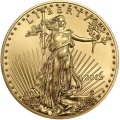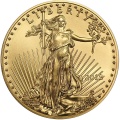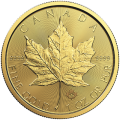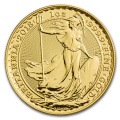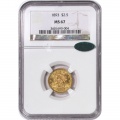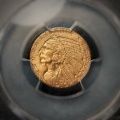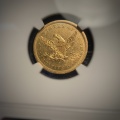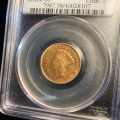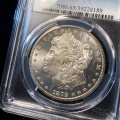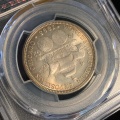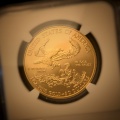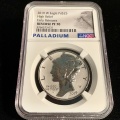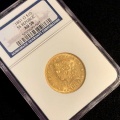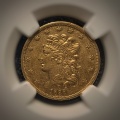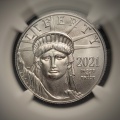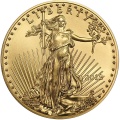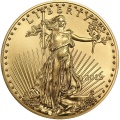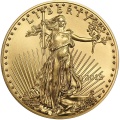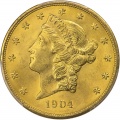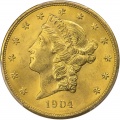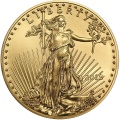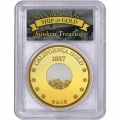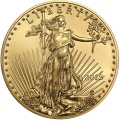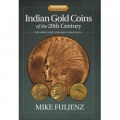Great Collectors
"GREAT COINS. GREAT COLLECTORS"
Coin collecting used to be called "The Hobby of Kings" because primarily wealthy aristocrats pursued it. Today, it has been rechristened "The King of Hobbies" - and far from being the province of the elite, it's a thoroughly democratic pastime enjoyed by people of all ages, social strata and income levels. Its popularity has grown so dramatically, the U.S. Mint now astoundingly estimates there are 140 million collectors in the United States alone.
Coin collecting combines the excitement of a treasure hunt and the thrill of discovery with healthy doses of history and romance. Coins are often described as "history in your hands," and the term is entirely accurate. Those gold coins in today's hobby holders might well have been retrieved from a 19th-century shipwreck - or possibly recovered from the loot of an Old West train robbery. Or, they might have spent decades in one of the great collections from a bygone generation. Gold is impervious to corrosion, so even after centuries at the bottom of the ocean, gold coins often emerge looking good as new.
Scarcer, more valuable coins seldom turn up in circulation; they have to be purchased at a premium. Through the years, however, these have often over time proven to be extremely sound investments for those who bought them wisely - particularly those who concentrated on coins of unusual rarity, exceptional quality, or both. While their owners appreciate the history and beauty they embody, they often appreciate in value.
In some past bull markets, coins have drawn greater interest - and brought higher prices - when sold as components of comprehensive special collections, more so than when they have been offered individually. In such cases, the whole, so to speak, has been greater than the sum of its parts. One reason for this is that fine collections often showcase the coins in the most appealing way and thus attract a broader pool of potential buyers. Indeed, the value of some coins can increase substantially if they have reposed in fine, well-known collections. This quality, known as their "provenance," gives them a special aura in the eyes of many collectors, much as precious gems are considered more desirable if they once belonged to a monarch or a movie star.
Through the years, virtually all of the most famous - and most valuable - U.S. coins have belonged at various times to one or more of the greatest collectors in the hobby. This is partly a matter of economics. Often, great collectors have been men(and sometimes women) of considerable means, whose wealth enabled them to buy costly coins other hobbyists couldn't afford. But savvy shrewdness and reading reliable research materials have enabled people of far more modest means to build great collections, as well.
These collectors took different paths to reach their goals, but in the end they all achieved the same ultimate goal: the formation of collections that earned great admiration and rewarded them or their heirs with handsome profits. It's instructive to see how some of them did it.
Which coins have the greatest potential for price appreciation? A shorthand way to identify real winners is to see how well they satisfy what experts call the "five P's" - Popularity, Precious metal content, Pretty appearance, a high state of Preservation, and low Population, or available supply. Each of these elements enhances a coin's desirability - and when all five are present, its value can be extremely high.
Louis E. Eliasberg
The King of Coins
 Louis E. Eliasberg Sr. came to be known as "The King of Coins" after he accomplished a feat many thought to be impossible: Over a period of less than two decades, from 1934 to 1950, Eliasberg assembled the only complete collection of U.S. coins - the only one that contained regular-issue coins of every denomination from every date they were issued and every mint that made them in those years. News of this achievement not only electrified fellow hobbyists, but also impressed the entire nation. It was considered so significant that Life magazine, then required reading for millions of Americans, featured Eliasberg and his coins in a lavish photo layout.
Louis E. Eliasberg Sr. came to be known as "The King of Coins" after he accomplished a feat many thought to be impossible: Over a period of less than two decades, from 1934 to 1950, Eliasberg assembled the only complete collection of U.S. coins - the only one that contained regular-issue coins of every denomination from every date they were issued and every mint that made them in those years. News of this achievement not only electrified fellow hobbyists, but also impressed the entire nation. It was considered so significant that Life magazine, then required reading for millions of Americans, featured Eliasberg and his coins in a lavish photo layout.
Yet, this "King of Coins" didn't have kingly wealth. He lived comfortably on his income as a Baltimore banker, but his budget for buying coins was not unlimited. Nor was he known as a big spender: Dealers who did business with him found him to be a cautious buyer who took out his checkbook only after carefull deliberation.
Eliasberg wasn't even a hobbyist when he started buying coin: He did so as a way to circumvent the Gold Surrender Order of 1933, which required U.S. citizens to turn in their gold coins, but exempted collectible coins. "I realized the only way I could legally acquire gold was by becoming a numismatist," he explained years later. "So in 1934, to the extent of my means, I started buying gold coins."
 Soon bitten by the hobby bug, he started buying other coins as well, and within a few years he had built a respectable collection. Then, in 1942, came a marvelous opportunity: He was able to purchase outright the outstanding collection of John H. Clapp- in the process acquiring many rare coins he didn't already possess. That's when he began thinking seriously of pursuing the impossible dream: a U.S. coin collection with "one of everything." He prepared a list of coins he lacked and started tracking them down in auctions and dealers' inventories.
Soon bitten by the hobby bug, he started buying other coins as well, and within a few years he had built a respectable collection. Then, in 1942, came a marvelous opportunity: He was able to purchase outright the outstanding collection of John H. Clapp- in the process acquiring many rare coins he didn't already possess. That's when he began thinking seriously of pursuing the impossible dream: a U.S. coin collection with "one of everything." He prepared a list of coins he lacked and started tracking them down in auctions and dealers' inventories.
"Eliasberg struck me as a gentleman," one prominent numismatist later recalled. "He was tall, aristocratic, a genius at finance, but he didn't know very much about coin.. He knew more about making money." His success at making money has become the stuff of legends in the coin collecting community. During the decade and a half it took him to complete his collection,Eliasberg spent less than $400,000. When the collection was sold, at a series of auctions between 1982 and 2005, it realized a grand total of roughly $55 million - more than 100 times what he had paid.
The gold coins he started buying in 1934 not only turned Eliasberg from a numismatic novice into a great collector, but also ended up confirming his status as a very successful investor: When his heirs put them up for sale in 1982, they brought more than $12 million. In short, even if he had never begun pursuing the seemingly impossible dream of collecting "one of everything," Eliasberg would have made millions just through his decision to buy gold coins as collectibles.
John Jay Pittman
The Archetype Collector
 John Jay Pittman, like Louis Eliasberg, wasn't a man of great wealth. He made a good living as a chemical engineer for Eastman Kodak Co., and his budget contained sufficient discretionary income to allow him to purchase coins within reason. But he didn't have a fortune - even a small fortune - when he took up the hobby in earnest in the mid- 1940s. What he did have was a razorsharp mind and a keen eye for quality and value. He also had an uncanny instinct for spotting exceptional bargains, and he could close a deal better and faster than virtually anyone else.
John Jay Pittman, like Louis Eliasberg, wasn't a man of great wealth. He made a good living as a chemical engineer for Eastman Kodak Co., and his budget contained sufficient discretionary income to allow him to purchase coins within reason. But he didn't have a fortune - even a small fortune - when he took up the hobby in earnest in the mid- 1940s. What he did have was a razorsharp mind and a keen eye for quality and value. He also had an uncanny instinct for spotting exceptional bargains, and he could close a deal better and faster than virtually anyone else.
Few understood just how big those bargains were. It became clear to everyone, though, following Pittman's death in 1996. Between 1997 and 1999, the Pittman Collection was sold at a series of three public auctions for prices totaling more than $30 million - making it one of the most valuable coin collections ever sold at auction. Pittman's initial outlay probably came to just a few hundred thousand dollars.
Pittman was hardly a "closet" hobbyist; during more than 50 years of active collecting, he was widely known as a man with major holdings - enough rare coins, in fact, to fill many safe deposit boxes in his longtime hometown of Rochester, N.Y. Amazingly, though, his status as a world-class collector tended to be overshadowed by his role as a hobby leader.
In the late 1930s, a Rochester coin dealer first kindled Pittman's passion for coins. Before long, Pittman's interest in coins was burning brightly and he started putting together a formidable collection. His interests were many and varied, reflecting his restless nature and his sharp, inquisitive mind. Classic U.S. gold coins held special appeal for him.
"John was not a wealthy man, except in knowledge," a longtime friend recalled. "He was one of the smartest people I've ever known, with a wonderful memory, and he was way ahead of his time in terms of knowing which coins to buy. But he was on a definite budget."
Judged by today's standards, coin prices were incredibly low in the 1940s, when Pittman bought many of his coins. Still, few coins have risen in value as dramatically since then as those in his collection. At a time when most collectors put far less emphasis on quality than on rarity, Pittman had the foresight to insist upon the best - not only uncirculated quality, but also the very finest specimens he could afford.
Interestingly, Pittman never owned an 1804 silver dollar or a 1913 Liberty Head nickel. Those great rarities were far less costly 60 years ago than they are today - but nonetheless their prices were high in relation to other rare coins, so Pittman chose to spend his limited resources on coins that, in his opinion, were still "sleepers." Over the years, he found more than his share.
HERE ARE SOME EXAMPLES:
JOHN PITTMAN ACQUIRES KING FAROUK RARITIES
 Not everything Pittman bought was dirt-cheap. He trusted his judgment, though, and wasn’t afraid to take chances when he felt that quality, rarity or circumstances warranted such an approach. Perhaps his greatest risk came in 1954, when he traveled to Egypt for the Palace Collection auction sale, during which the Egyptian government dispersed the coin holdings of the colorful – and recently deposed – King Farouk. Pittman acquired some dazzling rarities at that sale. The reward made the risk well worthwhile: Pittman’s purchases later proved to be fabulous investments.
Not everything Pittman bought was dirt-cheap. He trusted his judgment, though, and wasn’t afraid to take chances when he felt that quality, rarity or circumstances warranted such an approach. Perhaps his greatest risk came in 1954, when he traveled to Egypt for the Palace Collection auction sale, during which the Egyptian government dispersed the coin holdings of the colorful – and recently deposed – King Farouk. Pittman acquired some dazzling rarities at that sale. The reward made the risk well worthwhile: Pittman’s purchases later proved to be fabulous investments.
- In 1945, he paid $7.50 – just three times face value – for a choice uncirculated 1911-D Indian Head quarter eagle ($2.50 gold piece). At the Pittman Sale, it brought $26,400.
- In 1950, he paid $77.50 for a gem uncirculated 1915 Indian Head eagle. At the sale, it brought $51,700. (The price he paid at a 1950 auction was almost double the cataloger’s estimate of $40.) John wasn’t afraid to pay extra for special quality and it worked out for him.
- In 1951, he paid $60 for an uncirculated 1887-S Double Eagle ($20 gold piece). At the sale, it fetched $7,700, a price more than 128 times higher than his original acquisition cost.
Harold Bareford
The Golden Eye for Perfection
New York City lawyer Harold Bareford had similarly flawless instincts, and left his own distinct legacy. Bareford bought most of his coins in the decade just after World War II. During that time, he formed one of the most stunning collections of U.S. gold coins ever seen.
Bareford wrote a note in 1947 summing up his coin-buying philosophy: “I collect only the finest specimens, and am not interested in any coin which is not perfect.” Many coin buyers are quality-conscious today, but few of Bareford’s contemporaries were nearly as demanding at the time.
He was equally meticulous regarding the records he kept, making it easy to track the performance of his coins. His records show, for instance, that in 1947 he paid just $310 for a 1933 eagle ($10 gold piece). When his heirs sold it in 1978, it brought an astounding $92,500 – nearly 300 times what he had paid. And coin prices then were well below present-day levels.
In all, Bareford’s gold coins fetched about $1.2 million – 87 times his original outlay of $13,832. And, by one expert’s estimate, they would bring 10 times more than that if offered for sale today.
Some might wonder whether such profits will ever be possible again. With coin prices today so much higher than 60 years ago, it’s hard for them to imagine comparable gains in the future. But Harold Bareford’s story offers yet another lesson in historical perspective: Bareford all but stopped buying U.S. coins in 1955 because, in his opinion, they had gotten too expensive. Even then, of course, they were still tremendous bargains when viewed with the benefit of hindsight.
ELIASBERG, PITTMAN & BAREFORD: CLASSIC U.S. COIN SET BUILDERS
Louis Eliasberg, John Pittman and Harold Bareford all are regarded today as great collectors. But none of them was born with a silver spoon in his mouth. Rather, all three developed a golden touch through reading reliable award-winning research materials, showing shrewd judgment, paying close attention to quality and rarity, with a focused emphasis on set building and detail, while understanding that those who invest time and effort in the hobby will get the biggest return.
In short, coin collecting has something for everyone – and it offers the most to those who put the most into it. It has been said before that if one wishes to be successful in any endeavor, one would be wise to study the habits of those who have already been successful and mirror their habits.
Collectors like John Pittman and many others are worthy models from which anyone can learn.


